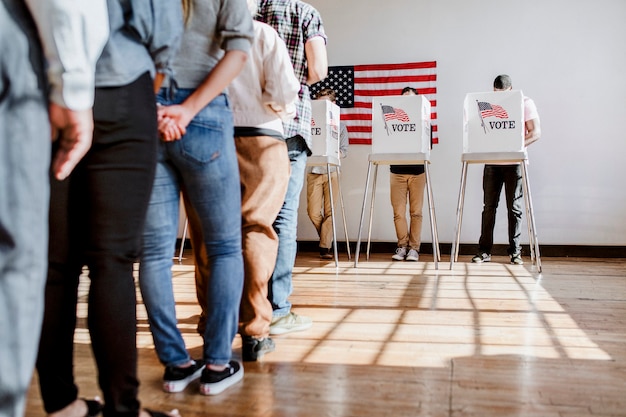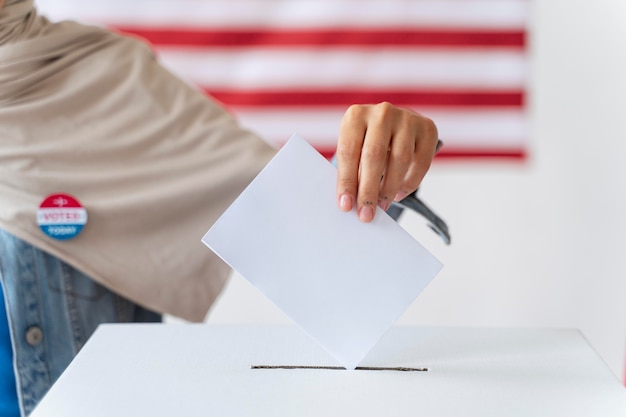Ranked-Choice Voting: Could It Change the 2025 US Elections?

Ranked-choice voting (RCV) is an electoral system where voters rank candidates by preference, potentially leading to broader representation and more strategic campaigning, with ongoing debates about its possible implementation in the 2025 US elections and beyond.
Is the future of US elections about to change? Ranked-choice voting, or RCV, is gaining traction, prompting widespread discussions about its potential implementation in the 2025 elections. Could this system reshape how Americans cast their ballots and influence election outcomes?
Understanding Ranked-Choice Voting: A Comprehensive Overview
Ranked-choice voting might sound complex, but the core idea is simple: instead of just picking one candidate, voters get to rank them in order of preference. This system aims to ensure that the winning candidate truly has the support of a majority of voters.
With ranked-choice voting, if no candidate secures a majority of first-preference votes, the candidate with the fewest votes is eliminated. Those who voted for the eliminated candidate have their votes transferred to their next preferred choice. This process continues until a candidate receives a majority.
How Does Ranked-Choice Voting Work?
RCV involves a multi-round process. Initially, voters submit their ranked preferences. Then, election officials proceed through rounds of tabulation, dropping the candidate with the least support in each round and reallocating votes based on voters’ next preferences. This continues until a single candidate has the support of over 50% of the voters.
Benefits and Drawbacks of Ranked-Choice Voting
Advocates for RCV argue it leads to more moderate candidates and reduces negative campaigning, as candidates need to appeal to a broader base. Opponents, on the other hand, argue it can be confusing for voters and can lead to unexpected outcomes.
- Reduces Negative Campaigning: Candidates are incentivized to seek second and third-choice votes, promoting a more civil discourse.
- Wider Representation: RCV ensures the winning candidate has majority support, reducing the chances of a candidate winning with a fragmented vote.
- Potential Confusion: Some voters may find the ranking process confusing, leading to unintentional disenfranchisement.
- Unpredictable Outcomes: It is possible for a candidate with a strong initial lead to eventually lose in later rounds.

Ultimately, the debate over ranked-choice voting comes down to whether its benefits outweigh its complexities. While it offers a more nuanced approach to voting, it also requires voters to be more informed and engaged in the electoral process.
The Current Landscape: Where is RCV Used?
Ranked-choice voting isn’t just a theoretical concept; it’s currently being used in various places across the United States. Understanding where RCV is employed and how it operates in practice can provide valuable insights into its potential impact on the 2025 elections.
RCV is already in use in several cities and states. Maine was the first state to adopt RCV for federal elections, while cities like Minneapolis and New York City have used it in municipal elections. Each implementation offers valuable lessons about the system’s strengths and challenges.
States and Cities Using Ranked-Choice Voting
Maine’s adoption of RCV for federal elections has been particularly noteworthy, with several election cycles providing data on its performance. Meanwhile, cities like Minneapolis have decades of experience with RCV, offering a long-term perspective on its effects.
Lessons Learned from Current Implementations
The experiences in these areas have highlighted both the advantages and disadvantages of RCV. While some have reported increased voter satisfaction and more representative outcomes, others have faced challenges related to voter education and technological infrastructure.
- Increased Voter Satisfaction: Studies have shown that many voters find RCV to be a more fair and representative system.
- More Representative Outcomes: RCV can lead to the election of candidates who are more broadly supported by the electorate.
- Voter Education Challenges: It’s crucial to educate voters on how the ranking process works, to avoid confusion and ensure accurate ballot completion.
- Technological Infrastructure Needs: Election systems must be updated to accurately tabulate ranked ballots, which can require significant investment.
The current landscape of RCV provides a real-world understanding of its potential and limitations. As more jurisdictions consider adopting RCV, the experiences of these pioneers will be invaluable.
Pros and Cons of Implementing RCV in the 2025 Elections
As the 2025 elections approach, the debate over implementing ranked-choice voting is heating up. Examining the potential benefits and drawbacks is essential for making informed decisions about its suitability for national elections.
The advantages of RCV include promoting more moderate candidates, reducing the likelihood of “spoiler” candidates, and ensuring the winner has majority support. However, it also has potential disadvantages such as voter confusion, increased complexity, and potential for strategic gaming of the system.
Arguments in Favor of Ranked-Choice Voting
Proponents of RCV argue that it leads to more civil campaigns, as candidates need to appeal to a broader range of voters to secure second and third-choice preferences. It also helps to avoid situations where a candidate wins with a plurality but not a majority of votes.
Arguments Against Ranked-Choice Voting
Critics of RCV worry about voter confusion, particularly among those who are less familiar with the system. They also point out that it can be more complex and time-consuming to tabulate votes, potentially leading to delays in election results.
- More Civil Campaigns: RCV incentivizes candidates to seek broader support, leading to less divisive rhetoric.
- Reduces “Spoiler” Candidates: By allowing voters to rank candidates, RCV reduces the risk of a third-party candidate significantly impacting the outcome.
- Voter Confusion: Some voters may find it difficult to rank candidates in order of preference.
- Increased Complexity: The tabulation process for RCV is more complex than traditional voting methods.
A balanced assessment of the pros and cons can help policymakers and voters decide whether RCV is the right choice for their elections.
Voter Education: Preparing for a Potential RCV Rollout
If ranked-choice voting is to be implemented in the 2025 elections, voter education will be essential. Ensuring that voters understand how the system works can help prevent confusion and increase participation.
Effective voter education programs should include clear explanations of the ranking process, examples of how ballots are tabulated, and opportunities for voters to practice using the system. Community outreach and accessible resources are also important.
Key Components of a Voter Education Program
A comprehensive voter education program should cover the basics of RCV, address common misconceptions, and provide resources for voters to learn more. It should also be accessible to all voters, regardless of their background or experience.
Tools and Resources for Voter Education
Various tools and resources can be used to educate voters about RCV, including videos, infographics, interactive simulations, and in-person workshops. Partnering with community organizations and local media can also help to reach a wider audience.

- Clear Explanations: Use simple language and visuals to explain the ranking process.
- Address Misconceptions: Correct common misunderstandings about RCV.
- Accessible Resources: Offer materials in multiple languages and formats.
- Community Outreach: Partner with local organizations to reach diverse communities.
Investing in voter education is crucial for the successful implementation of ranked-choice voting. By ensuring that voters are informed and prepared, we can promote fair and accurate elections.
The Role of Technology in Implementing Ranked-Choice Voting
Technology plays a significant role in the successful implementation of ranked-choice voting. From ballot design to tabulation software, technology can streamline the process and ensure accurate results.
Electronic voting machines and specialized software can simplify the ranking process and automate the tabulation of votes. Security and transparency are also essential considerations, ensuring that the system is protected from tampering and that results can be easily verified.
Electronic Voting Machines and RCV
Many modern electronic voting machines are compatible with RCV, allowing voters to easily rank their preferences on a digital interface. These machines can also provide real-time updates on vote tallies, improving transparency and efficiency.
Ensuring Security and Transparency
Security is a top priority when implementing RCV with technology. Systems must be protected from hacking and manipulation, and there should be clear audit trails to ensure that results can be verified. Transparency is also important, allowing the public to observe the tabulation process and have confidence in the outcome.
- Electronic Voting Machines: Simplify the ranking process with user-friendly interfaces.
- Tabulation Software: Automate the tabulation of ranked ballots.
- Security Measures: Protect against hacking and manipulation.
- Audit Trails: Ensure results can be verified and audited.
By leveraging technology effectively, we can ensure that ranked-choice voting is implemented smoothly and securely, promoting confidence in the electoral process.
Potential Legislative Challenges and Paths Forward
Implementing ranked-choice voting on a national scale could face significant legislative challenges. Understanding these hurdles and identifying potential paths forward is essential for RCV advocates.
One of the main challenges is overcoming partisan divisions, as RCV has been supported by members of both parties in some areas but opposed by others. Legal challenges related to constitutionality and voter rights could also arise. Collaboration and compromise will be necessary to navigate these obstacles.
Overcoming Partisan Divisions
Building consensus around RCV will require addressing concerns from both sides of the aisle. Highlighting the potential benefits for all voters, regardless of party affiliation, can help to bridge the divide.
Addressing Legal Challenges
Legal challenges to RCV have focused on issues such as equal protection and freedom of association. Addressing these concerns through careful ballot design and clear legal frameworks can help to ensure that RCV is upheld in the courts.
- Build Consensus: Address concerns from both parties to foster support.
- Address Legal Concerns: Design ballots and legal frameworks to withstand challenges.
- Promote Bipartisan Support: Highlight the potential benefits for all voters.
- Collaboration and Compromise: Find common ground to move forward.
Despite these challenges, there are clear paths forward for implementing RCV. By working together and addressing concerns proactively, we can improve the electoral process for all Americans.
The Future of Ranked-Choice Voting in US Elections
The future of ranked-choice voting in US elections is uncertain, but its potential impact is undeniable. As more states and cities consider adopting RCV, it’s important to consider the long-term implications.
Whether RCV is widely adopted or remains a niche system, its impact will depend on how effectively it is implemented and how well voters are educated about its benefits. The debate over RCV is likely to continue for years to come, but its potential to transform US elections is clear.
Long-Term Implications of RCV
Wider adoption of RCV could lead to more moderate candidates, reduced negative campaigning, and more representative outcomes. However, it could also lead to increased complexity and potential for strategic voting.
The Ongoing Debate
Despite its potential benefits, RCV has faced strong opposition in some areas. Opponents argue that it is confusing for voters and can lead to unexpected results. The debate over RCV is likely to continue for years to come.
- More Moderate Candidates: Encourages candidates to appeal to a broader range of voters.
- Reduced Negative Campaigning: Incentivizes candidates to seek second and third-choice preferences.
- Potential Complexity: Some voters may find the ranking process confusing.
- Strategic Voting: Voters may attempt to game the system by ranking candidates strategically.
The future of ranked-choice voting will depend on the choices we make today. By engaging in informed discussions and considering the evidence, we can make decisions that promote fair and accurate elections.
| Key Aspect | Brief Description |
|---|---|
| 🗳️ Ranked-Choice Voting | Voters rank candidates; if no majority, lowest candidate is eliminated until one wins. |
| ✅ Pros of RCV | Leads to more moderate candidates and reduces negative campaigning. |
| ❌ Cons of RCV | Can be confusing for voters and may lead to unexpected outcomes. |
| 🏫 Voter Education | Crucial for successful RCV implementation to clarify ranking and tabulation. |
Frequently Asked Questions
▼
The main goal is to ensure the winning candidate has the support of a majority of voters, even if no one wins a majority in the first round.
▼
Ranked-choice voting is used in several cities and states, including Maine for federal elections and cities like Minneapolis and New York City.
▼
Potential benefits include more civil campaigns, reduced risk of “spoiler” candidates, and more representative outcomes.
▼
Concerns include voter confusion, increased complexity in tabulation, and potential for strategic voting to manipulate results.
▼
Conclusion
In conclusion, ranked-choice voting presents both opportunities and challenges for the future of US elections. Its potential to promote more representative outcomes and reduce negative campaigning is tempered by concerns about voter confusion and implementation complexities. As the debate continues, it’s crucial for policymakers and voters to carefully consider the evidence and weigh the pros and cons before deciding whether RCV is the right choice for their communities.
